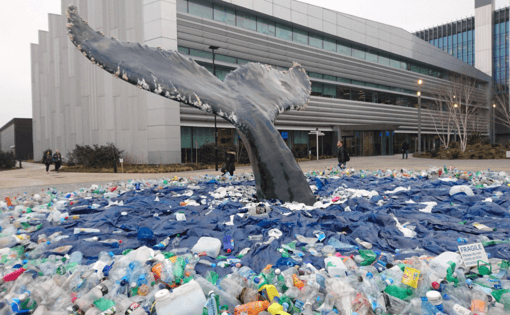
Photo by zoetnet | CC BY 2.0
In the annals of human history, modern day society is already setting records never before dreamed possible, as human-trashed plastic officially kills a six-ton six-year-old sperm whale. Yes, and it only took a total of 64 pounds of plastic to do the nasty deed.
An autopsy of the dead whale found on a beach in southern Spain brought to light the cause of death, which according to experts at El Valle Wildlife Rescue Centre concluded the whale was unable to digest or excrete plastic it ingested. The official cause of death is termed peritonitis, which is an infection of the inner lining of the stomach.
Additionally, according to Consuelo Rosauro, director-general for natural environment of the region, this is not a “one-off” situation. He informed The Telegraph (April 6, 2018) that many animals die from the horrid “Plastic Sudden-Death Epidemic.”
Interestingly, and somewhat ironically, the sperm whale has the biggest brain of any creature on Earth and a life expectancy of 70 years, similar to humans, except for brain size, which is much bigger than human brains… hmm! Still, it’s human thinking (“processing”) with resultant behavior, carelessly, and maybe even sadistically instinctively, tossing plastic waste somewhere on the planet, ending up in the young sperm whale’s stomach.
It would be absolutely fascinating to connect each discarded piece of plastic to the original human hand(s) that tossed it aside. Then, maybe bring together all of those human animals to commemorate the whale’s untimely death at the spot in southern Spain where it washed ashore. And, since the authorities retrieved all of the plastic from the young whale’s stomach, insist that each of the perpetrators select their own piece of plastic, sorting it out from within the batch of 64 pounds of plastic, and take it, hold it, maybe for a couple of hours, and carry it to a proper plastic recycling facility. This entire commemoration could be filmed for posterity to honor the short lifespan of the young sperm whale. And, this will make the perpetrators feel better about themselves, maybe.
But, it is impossible to trace the pieces of plastic back to each person that originally tossed it aside. The plastic may have come from “who knows from where?” Here’s the problem: Male sperm whales have no predetermined migration patterns. They are wanderers and travel the entire world’s oceans, which makes it all the harder to determine where the plastic originated. On second thought, plastic is found throughout the world’s oceans, making it even more difficult to understand the origin.
The problem of understanding the origin of the plastic is further complicated by the fact that, according to National Geographic, at current rates of haphazard plastic waste disposal, by mid-century the oceans will contain more plastic waste ton-for-ton than fish. Then, imagine the problem identifying the origin of the plastic that kills another sperm whale, or by then, many sperm whales, assuming they have not already been completely wiped-out by the nasty unrelenting Plastic Sudden-Death Epidemic.
The amount of plastic that will displace all of the ocean’s fish amounts to 5-to-14 million tons per year, the current amount of plastic waste haphazardly thrown out per year, or enough plastic end-to-end to travel halfway to Mars. That calculation comes from engineering professor Jenna Jambeck/University of Georgia.
A human trip to Mars will likely take 6-to-8 months. So, the annual ocean plastic calculation is roughly equivalent to 3-4 months travel time in outer space. The correlation is not perfect, as the concept is awkward in the first instance, but trying to understand “plastic whale death” is so insanely screwball wacky that nothing makes sense anyways.
Nowadays, insanity may be the only reprieve from reality.
Especially when absorbing the thought processes behind the realization that, in January 2016, 29 sperm whales stranded on the shores around the North Sea. Necropsies (animal equivalent of autopsies) showed several stomachs filled with plastic, full up!
These horrifying Plastic Sudden-Death Epidemic stories seem endless but sorrowfully, sea animal abundance is not.
What to do?
Do something!
A good starting point for human animals that really, truly care can be found at Mission Blue, headed by the National Geographic Society Explorer in Residence Dr. Sylvia A. Earle, aka: “Her Deepness.”
Or, a really good alternative, don’t toss plastic into the ocean or into the street where storm sewers ultimately take it to a body of water somewhere in the world, or also a good idea, be sure to recycle.
According to National Geographic, 90% of plastic is not recycled.
Where does it go?
Sperm whales!
Really?
Yes, really… honestly… we’ve got hard evidence!